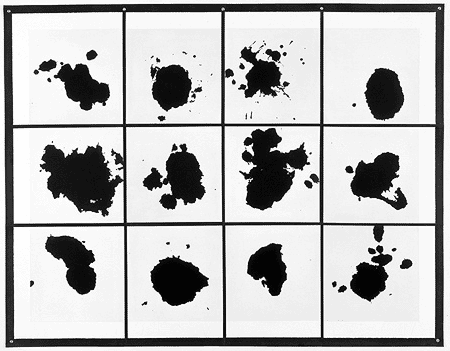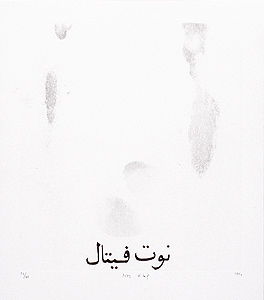Not Vital
Snowball, 1998
A solid sphere of white glass within clear glass (suggesting a snowball in ice).
Each example is a unique irregular sphere, diameter approximately 6 to 7 in. - 15 to 18 cm.
Edition of 14 plus 3 artist’s proofs. Signed, numbered and dated by engraving.
Fabricated by Pino Signoretto at Vetreria Pino Signoretto, Murano, Italy.
Dung, 1997
Twelve lift-ground aquatints mounted on a single piece of dyed cloth.
Working in his village in the Swiss Alps and in a dairy farm in Pennsylvania, the artist dropped cow dung onto each of twelve copper plates. The plates were sprayed with a resist (spraypaint), the dung was removed, an aquatint was applied and the plates were etched. The twelve prints were then mounted on cloth in rows of three from top to bottom and four from side to side.
Plate size: 17 1/4 x 17 1/4 in. Sheet size: variable among the 12 prints. Complete work: 62 1/2 x 80 1/2 in.
Edition of 8.
Paper: Somerset.
Plates processed and printed by Felix Harlan and Carol Weaver, New York.
Mounting of prints by J. Fields Studio, New York.
Several years ago Vital was traveling in a rural part of Nepal and a man approached him and told him that his son had been very badly scalded by boiling milk (burns account for 1/3 of casualties among children since it is common for families to live in one room huts with an open fire for cooking and heating, and the children, without toys or other distractions, are attracted to the fire). The father, desperate, asked for Vital’s help.
Vital came to see the boy and then rented a bus to bring the family to the hospital in Katmandu (a six hour trip). When he returned later to see how the boy was, the family was still waiting outside because the only empty bed was in a private room which cost two dollars a day. Not arranged for the private room and returned each day to deliver medicine and visit.
Later, back in Switzerland, Vital had the idea to make 1000 unique sculptures by casting 1000 pieces of (sun-dried) cow dung in bronze and to use the proceeds from sales of the sculptures to build a burns hospital in Katmandu (since 1990 he has raised more than $300,000). Vital liked the idea of turning cow dung, something valuable in Nepal (as in India) and worthless in Switzerland, into something valuable in Switzerland (though worthless in Nepal) by casting it in bronze, and by doing so he could use “good burning” to help bad burning.
Our project began when we visited Vital in Sent, his village in the Swiss Alps. He had some copper plates in his studio and asked us if etchings could be made from cow dung. We developed a technique on the spot based on supplies we found in a hardware store a couple of villages away. That same day we hiked up a mountain with the two copper plates, a shovel and can of spray paint. Vital dropped cow dung (fresh, not dried, this time) from the shovel onto each plate, then I covered each with spray paint. When the paint (acting as a resist) was dry, I removed the dung (which acted as lift-ground) and washed the plates with water (similar to “sugar-lift”).
Back in New York our printers added an aquatint and proofed the plates. Vital was so happy with the results he decided he wanted to make twelve prints and mount them on cloth “like the old maps in school rooms”, a map of twelve islands. Eventually we arranged for Vital to work in a dairy farm in Pennsylvania to make ten additional plates.
It is interesting that those who have seen this work have come up with very different “readings” of it; some see it as an example (or parody) of “Action Painting” of the drip & splatter school, for some it has an oriental or Zen like feeling, some see it as a map, as Vital does, etc.
Kiss, 1996
Lift-ground aquatint. The plate was made from the impression of two lambs coated with lift-ground solution additions painted in lift ground.
Plate size: 30 x 60 in. Sheet size: 34 x 64 in.
Edition of 28.
Paper: Somerset.
Plates processed and printed by Felix Harlan and Carol Weaver, New York.
"It is fascinating to see how Not can reconsider elements drawn from his favorite imagery, and bring to these images, here the lamb and the wheel, a freshness of vision. The lamb seems momentarily poised in time, suggesting energy coupled with vulnerability. And when Not juxtaposes the lamb with the wheel he conjures up for me not only a sense of the fragility of this young animal, but also a tender reminiscence of a child’s wheeled toy. The photographs documenting the creation of this print give further evidence of the directness and economy of Not’s art-making: mind and hand join in an eloquent gesture."
Roberta Waddell, Curator of Prints, NY Public Library, 1995
Notes, Too, 1984
Seven etchings, with aquatint and drypoint, within a linen covered portfolio with letterpress title and colophon page.
Plate size: 14 x 11 in. or 11 x 8 in. Sheet size: 20 3/4 x 17 in.
Edition of 27.
Paper: Hahnemühle.
Printed by Felix Harlan and Carol Weaver, New York.
Title and colophon pages by Grenfell Press, New York.
L'Asen Da Sent, 1992
Eight photo-etchings within a silver box, designed by the artist, with letterpress printed title and colophon page.
Plate size: 2 1/8 x 1 3/4 in. Sheet size: 3 7/8 x 2 7/8 in.
Edition of 24.
Odd numbers printed in blue (1/24, 3/24, 5/24 - 23/24, ap1/4 ap3/4, pp1/2),
even numbers printed in black, bon à tirer proof with prints alternately in blue or black.
Paper: Somerset Satin.
Plates processed and printed by Felix Harlan and Carol Weaver, assisted by Michael Wodkowski, New York.
Title and colophon page designed by Ken Botnick, Woodbridge, Connecticut.
Silver boxes made by Thomas Kurilla, New York.
El Maktoub Maktoub, 1990
Etching and aquatint on five sheets within a linen covered portfolio with letterpress printed title and colophon page.
Plate size: 14 x 121/2 in.
Sheet size: (a) 18 x 15 in. - (b), (c), (d) 16 x 15 in. - (e) 181/2 x 15 in.
Complete work: 86 x 15 in.
(size variable according to placement of the five sheets).
Edition of 48.
Paper: Rives bfk.
Printed by Piero Crommelynck, Paris.
Title and colophon page designed by Ken Botnick,Woodbridge, CT.
Published by Baron/Boisanté Editions, New York, and Piero Crommelynck, Paris.
Details views below:
Binoculars, 1988
A multiple of white Carrara marble within a found binoculars case.
The cases vary in style, size, shape and color. Each marble form was sculpted according to the unique dimensions of its particular case.
size: variable
edition: 12 unique examples
signed and numbered on marble (bottom)










